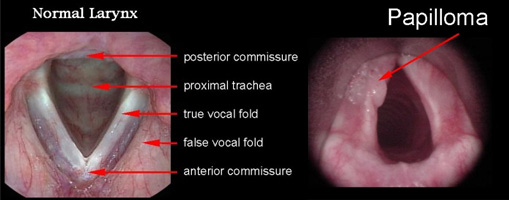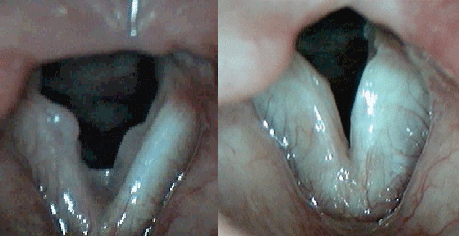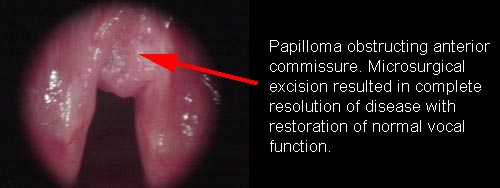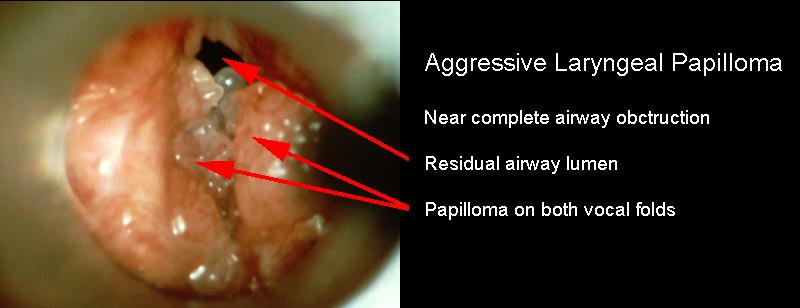
Papillomas are benign epithelial tumors that are caused by infection with the human papilloma virus (HPV). They are the most common benign neoplasms affecting the larynx and upper respiratory tract. Malignant degeneration to squamous cell carcinoma can occur, but is very rare. The overall prevalence ranges from 2 per 100,000 adults to 4.5 per 100,000 children. Thus, over 10,000 Americans suffer from respiratory papillomas.
Laryngeal papillomas are similar to verrucae on the skin (common wart) and condyloma acuminatum, or genital warts. Infection with the virus is ubiquitous. Using highly sensitive detection methods such as the polymerase chain reaction, estimates of infection with HPV range from 60 to 80% of women of childbearing age. Why some infected people develop clinical expression of papilloma (respiratory, genital, or cutaneous) and some people never develop clinical disease remains uncertain. The reality is that some individuals appear to be susceptible to the virus and others do not. Although some individuals can acquire the virus through intimate contact, the virus can be transmitted from mother to fetus and laryngeal (respiratory) papillomatosis is NOT considered a sexually transmitted disease.
The figure below on the left displays a fiberoptic image of a normal larynx. The image on the right displays an image of a laryngeal papilloma. The image is reversed because the patient is on his back at the time of endoscopic surgery. There is a papilloma on the anterior aspect of the left true vocal fold. If the papilloma is not removed carefully the vocal fold may scar and vocal change may occur.
Because of their propensity to recur after surgical removal, the disorder is often referred to as recurrent respiratory papillomatosis (RRP). The disorder is further classified into adult onset RRP (AORRP) and juvenile onset RRP (JORRP). This classification stems from the different clinical patterns affecting children and adults.
JORRP is typically identified in infancy or childhood. It usually presents as hoarseness or stridor (noisy respiration) and is characterized by extensive involvement of the larynx with frequent recurrences. There is some association between maternal genital warts and the development of RRP in children. The risk of developing JORRP in children born to mothers with active genital warts, however, is less than 0.5%. The virus has also been detected in the amniotic fluid of mothers with condyloma acuminata. Therefore, unless the warts are so large that they impede the birth canal, a cesarian section is seldom recommended.
Although papillomas are benign, their rapid growth can cause obstruction of the airway that can lead to asphyxiation if not treated. A tracheotomy may be necessary in some cases, but is avoided at all costs. The papilloma can affect the vocal folds and/or epiglottis, and can occasionally spread distally to involve the trachea or bronchi. Treatment usually consists of frequent laryngoscopies with surgical removal using the carbon dioxide (CO2) laser. Because the virus lives in the normal appearing tissue surrounding the papilloma, recurrence is likely, and repeated endoscopic removal is often necessary. Some children may require excision 1 to 2 times a month (usually done as an outpatient). The papillomas may spontaneously regress at puberty, although many children require treatment for a lifetime.
Adult onset RRP is usually more localized and less severe than its juvenile counterpart. A single laryngoscopy with excision is often adequate for cure. AORRP can occasionally, however, behave as aggressively as JORRP. Surgical excision with the CO2 laser is usually the treatment of choice. Great care must be taken not to damage the surrounding normal laryngeal epithelium, because vocal fold scar with permanent hoarseness may result. We are now performing in-office ablation of laryngeal papilloma using the pulsed-dye laser (PDL). The PDL can be used in the office through a flexible laryngoscope without the need for a trip to the operating room. The procedure is performed in an upright exam chair, may take 5 to 15minutes to complete, is generally painless, and can be repeated as necessary. The risk of a general anesthetic is avoided. The laser is considered a “smart” laser and specifically targets the papiloma without harming the normal laryngeal epithelium. The individual can return to work and resume normal activity immediately after the procedure.
The composite below shows a larynx before and after an in-office PDL treatmment of laryngeal papilloma. The image on the left displays laryngeal papilloma completely incorporating the mucosa of the vocal folds. The image on the right displays normal appearing vocal folds after 2 PDL treatments.
Although adjunctive therapy is seldom utilized since the introduction of the PDL, a thorough discussion of all patient options is still warranted.
Because of the aggressive nature of the disease in certain individuals, adjunctive therapies have been sought for treatment of RRP. Options such as radiation, vaccination, photodynamic therapy, and a variety of chemotherapeutic agents have been tried. Since the introduction of in-office laser therapy with the PDL, these adjunctive therapies have not been necessary. for treatment of RRP. Options such as radiation, vaccination, photodynamic therapy, and a variety of chemotherapeutic agents have been tried.
Interferons (in-ter-FEER-ons) are naturally produced substances in the body utilized to fight infections and tumors. Synthetic versions are also available. Although some investigators have reported success with the use of interferon for the treatment of aggressive RRP, frequent side effects such as fatigue, dizziness, malaise, body aches, headache and fever, as well as a propensity for the papillomas to recur after the interferon has been stopped, have prevented its wide spread use.
Indole-3-carbinol, a natural derivative of cruciferous vegetables (cabbage and broccoli), has been shown to alter the growth pattern of RRP. It appears to be safe and well tolerated and may prove to be a viable adjunctive treatment for aggressive RRP in certain patients.
Methotrexate (meth-o-TREX-ate) belongs to a class of chemotherapeutic agents called antimetabolites. This medication blocks an enzyme (dihydrofolate reductase) needed by tumor cells to live. Since the growth of normal body cells will also be affected, side-effects may also occur (blood, liver, or kidney problems, diarrhea, loss of hair, others). Some investigators have reported clinical benefit with the adjunctive use of methotrexate in certain patients with aggressive RRP. Additional study is needed, however, to further define its therapeutic efficacy.
Cidofovir (si-DOF-o-veer) is an antiviral medication that is used to treat viral infections. Recent use of this medication in treating RRP has shown some promise. To treat RRP, cidofovir has been injected directly into the papilloma (locally) at the time of endoscopy. There have been no serious reported side effects to our knowledge and some patients have experienced complete papilloma regression after multiple injections.
An association between laryngopharyngeal reflux and RRP has recently been observed. It is uncertain whether the irritation caused by refluxed stomach contents contributes to the development of papillomas, or whether the presence of papillomas predisposes one to reflux. Nonetheless, patients with RRP appear to have a high prevalence of LPR. Patients with LPR undergoing treatment for papilloma also appear to have a higher prevalence of surgical complications, most notably, the development of a laryngeal web. Further investigation is warranted.
SUMMARY
Respiratory papillomas are benign epithelial growths similar to warts on the skin. They are caused by a virus (HPV) and are subject to frequent recurrence. Our approach to persons with RRP is tailored to the specific needs of the individual. In an adult with AORRP, simple laser surgery with the PDL in the office may be curable. For bulky, airway obstructing disease, or for the rare individual who can not tolerate the office PDL procedure, a trip to the operating room may be necessary. This is performed under general anesthesia with either the CO2 laser, microdebrider, or “cold” microsurgical instruments under microscopic guidance to limit damage to healthy underlying tissue and preserve vocal function. The presence of reflux will be evaluated, and if present, will be controlled with anti-reflux medications. In the individual with a highly recurrent form of the disease, we utilize a more aggressive treatment regimen. If repeat surgical excision fails to result in regression, we will consider therapy with cidofovir, indole-3-carbinol, or one of the other available chemotherapeutic agents. The ultimate goal is complete disease regression and preservation of vocal function.



